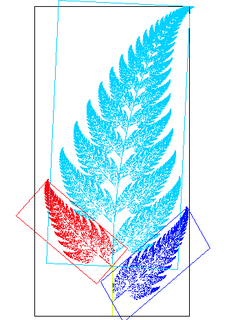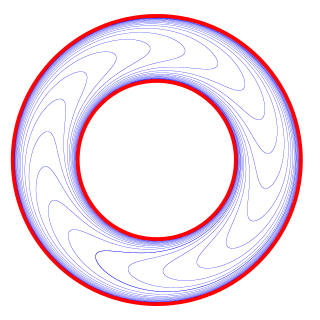In mathematics, a binary relation over sets X and Y is a subset of the Cartesian product ; that is, it is a set of ordered pairs (x, y) consisting of elements x in X and y in Y. It encodes the common concept of relation: an element x is related to an element y, if and only if the pair (x, y) belongs to the set of ordered pairs that defines the binary relation. A binary relation is the most studied special case n = 2 of an n-ary relation over sets X1, ..., Xn, which is a subset of the Cartesian product

In mathematics, when the elements of some set have a notion of equivalence defined on them, then one may naturally split the set into equivalence classes. These equivalence classes are constructed so that elements and belong to the same equivalence class if, and only if, they are equivalent.

A quotient group or factor group is a mathematical group obtained by aggregating similar elements of a larger group using an equivalence relation that preserves some of the group structure. For example, the cyclic group of addition modulo n can be obtained from the group of integers under addition by identifying elements that differ by a multiple of n and defining a group structure that operates on each such class as a single entity. It is part of the mathematical field known as group theory.

An integer is colloquially defined as a number that can be written without a fractional component. For example, 21, 4, 0, and −2048 are integers, while 9.75, 5+1/2, and √2 are not.

In mathematics, specifically abstract algebra, an integral domain is a nonzero commutative ring in which the product of any two nonzero elements is nonzero. Integral domains are generalizations of the ring of integers and provide a natural setting for studying divisibility. In an integral domain, every nonzero element a has the cancellation property, that is, if a ≠ 0, an equality ab = ac implies b = c.

In mathematics, a group is a set equipped with an operation that combines any two elements to form a third element while being associative as well as having an identity element and inverse elements. These three conditions, called group axioms, hold for number systems and many other mathematical structures. For example, the integers together with the addition operation form a group. The formulation of the axioms is, however, detached from the concrete nature of the group and its operation. This allows one to handle entities of very different mathematical origins in a flexible way, while retaining essential structural aspects of many objects in abstract algebra and beyond. The ubiquity of groups in numerous areas—both within and outside mathematics—makes them a central organizing principle of contemporary mathematics.

In mathematics, modular arithmetic is a system of arithmetic for integers, where numbers "wrap around" when reaching a certain value, called the modulus. The modern approach to modular arithmetic was developed by Carl Friedrich Gauss in his book Disquisitiones Arithmeticae, published in 1801.

In mathematics, a sequence is an enumerated collection of objects in which repetitions are allowed and order matters. Like a set, it contains members. The number of elements is called the length of the sequence. Unlike a set, the same elements can appear multiple times at different positions in a sequence, and unlike a set, the order does matter. Formally, a sequence can be defined as a function from natural numbers to the elements at each position. The notion of a sequence can be generalized to an indexed family, defined as a function from an index set that may not be numbers to another set of elements.

In Euclidean geometry, an affine transformation, or an affinity, is a geometric transformation that preserves lines and parallelism.

In set theory, the complement of a set A, often denoted by Ac, are the elements not in A.
A mathematical symbol is a figure or a combination of figures that is used to represent a mathematical object, an action on mathematical objects, a relation between mathematical objects, or for structuring the other symbols that occur in a formula. As formulas are entirely constituted with symbols of various types, many symbols are needed for expressing all mathematics.

In mathematics, specifically group theory, a subgroup H of a group G may be used to decompose the underlying set of G into disjoint equal-size subsets called cosets. There are left cosets and right cosets. Cosets have the same number of elements (cardinality) as does H. Furthermore, H itself is both a left coset and a right coset. The number of left cosets of H in G is equal to the number of right cosets of H in G. This common value is called the index of H in G and is usually denoted by [G : H].

An exact sequence is a sequence of morphisms between objects such that the image of one morphism equals the kernel of the next.

In mathematics, a function is a binary relation between two sets that associates each element of the first set to exactly one element of the second set. Typical examples are functions from integers to integers, or from the real numbers to real numbers.

In mathematics, a foliation is an equivalence relation on an n-manifold, the equivalence classes being connected, injectively immersed submanifolds, all of the same dimension p, modeled on the decomposition of the real coordinate space Rn into the cosets x + Rp of the standardly embedded subspace Rp. The equivalence classes are called the leaves of the foliation. If the manifold and/or the submanifolds are required to have a piecewise-linear, differentiable, or analytic structure then one defines piecewise-linear, differentiable, or analytic foliations, respectively. In the most important case of differentiable foliation of class Cr it is usually understood that r ≥ 1. The number p is called the dimension of the foliation and q = n − p is called its codimension.
In mathematics, a congruence subgroup of a matrix group with integer entries is a subgroup defined by congruence conditions on the entries. A very simple example would be invertible 2 × 2 integer matrices of determinant 1, in which the off-diagonal entries are even. More generally, the notion of congruence subgroup can be defined for arithmetic subgroups of algebraic groups; that is, those for which we have a notion of 'integral structure' and can define reduction maps modulo an integer.
In mathematics, the Grothendieck group construction constructs an abelian group from a commutative monoid M in the most universal way, in the sense that any abelian group containing a homomorphic image of M will also contain a homomorphic image of the Grothendieck group of M. The Grothendieck group construction takes its name from a specific case in category theory, introduced by Alexander Grothendieck in his proof of the Grothendieck–Riemann–Roch theorem, which resulted in the development of K-theory. This specific case is the monoid of isomorphism classes of objects of an abelian category, with the direct sum as its operation.
In mathematics, a CR manifold, or Cauchy–Riemann manifold, is a differentiable manifold together with a geometric structure modeled on that of a real hypersurface in a complex vector space, or more generally modeled on an edge of a wedge.
In mathematics, particularly in the area of number theory, a modular multiplicative inverse of an integer a is an integer x such that the product ax is congruent to 1 with respect to the modulus m. In the standard notation of modular arithmetic this congruence is written as
In computer science and mathematics, more precisely in automata theory, model theory and formal language, a regular numerical predicate is a kind of relation over integers. Regular numerical predicates can also be considered as a subset of for some arity . One of the main interests of this class of predicates is that it can be defined in plenty of different ways, using different logical formalisms. Furthermore, most of the definitions use only basic notions, and thus allows to relate foundations of various fields of fundamental computer science such as automata theory, syntactic semigroup, model theory and semigroup theory.































































